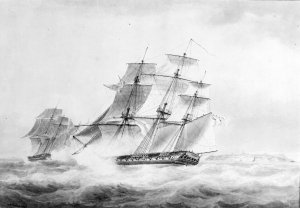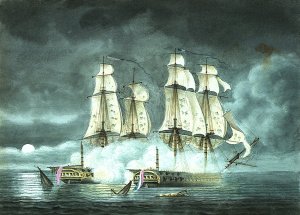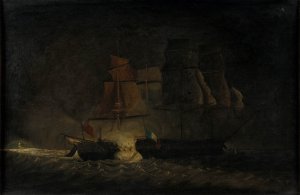Union Ships Blocking Detroit and Harbor Try Again Union Ships Blocking the Charleston Harbor
Today in Naval History - Naval / Maritime Events in History
ten November 1808 - HMS Amethyst (36), Cptn. Michael Seymour, captured French frigate Thetis (44), Cptn. Pinsun (Killed in Action).
HMS Amethyst was a Royal Navy 36-gun Penelope-grade fifth-rate frigate, launched in 1799 at Deptford. Amethyst served in the French Revolutionary Wars and the Napoleonic Wars, capturing several prizes. She also participated in 2 boat deportment and two ship actions that won her crew clasps to the Naval General Service Medal. She was broken upward in 1811 afterward suffering severe harm in a storm.

This was purchased for the Museum from Davis, a London dealer, past Sir James Caird in 1948 with PAH9534. It was then believed to show the frigate 'Amethyst' in hunt of the 'Thetis', ten November 1808, but was reidentified before 1975 when information technology was shown in the NMM Pocock exhibition (no. 29) under the title above. Another version with small variations, and formerly in the collection of Sir Bruce Ingram, was acquired past the Ministry of Works in 1953.
Read more at http://collections.rmg.co.great britain/collections/objects/149482.html#yhXVodhcfXXUIKZb.99
French Revolutionary Wars
Amethyst was deputed in May 1799 under the command of Captain John Cooke. She and so operated on the Dutch coast later on that yr. During the Anglo-Russian invasion of Holland, Amethyst conveyed the Knuckles of York to the Netherlands and subsequently participated in the evacuation of the force post-obit the campaign's collapse.
On 18 December she and Beaulieu recaptured the brig Jenny. Eleven days after that, Amethyst and Beaulieu recaptured the ships Dauphin, Cato, Cabrus, and Nymphe.
On 29 December Amethyst captured the French privateer brig Aventurier (or Avanture). Aventurier, out of Lorient, was armed with 14 guns and had a crew of 75 men. I calendar month earlier, on 29 November, Aventurier had captured the American ship Cato and taken her principal, John Parker, and his crew prisoner. When Amethyst captured Aventurier Cooke freed the Americans and informed Parker that Cato had been sent to Cork. Cooke sent Aventurier into Plymouth from where Parker and his mate traveled to Cork.
On 7 January 1800, the French armed send Huzelle (or Ursule), came into Plymouth. She had been carrying passengers from Cayenne, including women and children, when Amethyst captured her. On her way into a British port, the French privateer Providence, of 14 guns and 152 men, had recaptured her and sent her to Bordeaux. All the same, before she got get there, Beaulieu and Unicorn again captured her and sent her into Plymouth. Huzelle was low on provision with the result that a v-year-old child died while she was in Plymouth Sound; every bit she anchored at Catwater, M.P. Symonds, the broker for the prize, delivered fresh provisions to Huzelle. Amidst Huzelle's passengers were a Colonel Molonson of Invalids, and a naturalist, M. Burnelle, with a cabinet of curiosities for the French National Museum at Paris.
Later that calendar month, on the 26th, Oiseaux encountered the French frigate Dédaigneuse and gave hunt. Sirius and Amethyst joined the next day. On the 28th Oiseaux and Siriuseffected the capture. Unfavourable winds kept Amethyst from joining the activeness. She was brought into Royal Navy service as HMS Dedaigneuse.
In February 1800 Amethyst was in company with Nymphe when on xv February they captured the French privateer cutter Valiant (or Vaillante), of Bordeaux, after a long chase. Valiant was armed with one long eighteen-pounder, ii long 12-pounder, and twelve 6-pounders guns. She had a crew of 131 men who had been out four days, just had not withal captured anything.
On 24 February, Nymphe, in company with Amethyst, captured the French letter of the alphabet of marque Modeste, of about 600 tons burthen. She was pierced for 16 guns and had a crew of seventy men. She had left the Île de France some nine weeks before and was sailing for Bordeaux with a cargo of cotton, java, tea, saccharide, indigo, and the like. Still in company with Nymphe, Amethyst captured Julius Pringle and recaptured Active (4 March) and Amity (21 March).
Then on 31 March, Amethyst, with Nymphe, captured the French privateer Mars. Mars was armed with twenty 12-pounder guns and ii 36-pounder obusiers, and carried a crew of 180 men. Cooke described her as being "one of the finest Privateers fitted out of Bourdeaux." The British took Mars into service every bit Garland.
Amethyst also captured a valuable American ship attempting to dock in a French port. This may take been Caroline, captured on 14 April.
In early June Cooke met upward with Captain Sir Edward Pellew'south squadron at Quiberon Bay. The squadron engaged in a successful large calibration raid on Morbihan, though Amethyst's function, if whatever, is unclear.
Amethyst was among the vessels of a squadron that shared the proceeds for the recapture on 28 June 1800 of Lancaster. She was as well part of Pellew'due south squadron, which shared in the proceeds of the capture of Vigilant, Menais, Insolent, Ann, and the wreck of a vessel that was sold, and the recapture of Industry.
On 29 July, a gunkhole each from Viper, Impetueux and Amethyst, all manned by volunteers under the command of Lieutenant Jeremiah Coghlan of Viper, cut out the French naval brig Cerbère, armed with three 24-pounder and iv 6-pounder guns. Cerbère was manned by 87 men under the command of lieutenant de vaisseau Menage and was moored in a port within pistol-shot of 3 batteries and near a number of naval vessels. The attack was a success, with the British boarding party of some xx men losing simply one man killed and eight wounded, including Coghlan; none of the casualties were from Amethyst's boat, which did not accept office in the actual boarding. The French lost vi men killed and twenty wounded. In adoration for the feat, Pellew's squadron gave upwards their share of the prize money, with the issue that it accrued in its entirety to the cutting-out party. In 1847 the Admiralty awarded the Naval General Service Medal with clasp "29 July Boat Service 1800" to the four surviving claimants from the activity.
Adjacent, Amethyst participated in an bootless invasion of Ferrol. On 29 August, in Vigo Bay, Admiral Sir Samuel Hood assembled a cut-out party from the vessels nether his command consisting of ii boats each from Amethyst, Stag, Amelia, Vivid, and Cynthia, four boats from Courageaux, as well as the boats from Renown, London, and Impetueux. The party went in and after a xv-minute fight captured the French privateer Guêpe, of Bordeaux, and towed her out. She was of 300 tons burthen and had a flush deck. Pierced for twenty guns, she carried eighteen nine-pounders, and she and her coiffure of 161 men were under the command of Denizen Dupan. In the attack she lost 25 men killed, including Dupan, and forty wounded. British casualties amounted to four killed, 23 wounded and one missing. In 1847 the Admiralty awarded the Naval General Service Medal with clasp "29 Aug. Boat Service 1800" to all surviving claimants from the action.
On nine Oct, Amethyst returned to Plymouth from a surreptitious mission. She and Nymphe would share in the prize money for a captured a French East Indiaman. During their stay in port the prize netted them £36,000.
In 1801, Amethyst operated off Espana, capturing two Spanish privateers and the French corvette Général Brune. On 26 January, Oiseaux encountered Dédaigneuse and gave chase while unfavorable winds kept Amethyst from joining the activeness. The British brought Dédaigneuse into Imperial Navy service as HMS Dedaigneuse.
Later on 28 January Sirius and Amethyst captured the Spanish Letter of Marque Charlotta (or Carlotta) of Ferol, sixteen hours out of Ferol on her way to Curaçao. The capture took place about six or 7 leagues from Greatcoat Belem in Galicia. The hired armed cutter Earl St Vincent shared in the capture.
...................................................
In October 1801 Captain Charles Taylor took control of Amethyst, only to be replaced in the side by side calendar month by Captain Henry Glynn, for the North Body of water. During the Peace of Amiens, Amethyst sailed on anti-smuggling patrols off the declension of Scotland nether the command of Helm Alexander Campbell.
During the autumn and winter of 1802–03 Amethyst was sent to the Northern Station, based at Leith. On Midweek 27 October 1802, 38 miles off Tod Head, she captured Vlugheid, smuggling cutter from Flushing. Aboard were John Dangerfield and 11 other seamen. On xviii November 1802, 3 or four leagues from the Isle of May, Campbell captured Fly, a smuggling lugger from Flushing, "laden with 570 Ankers of Gineva and 80 v Bails of Tobacco". On Tuesday 30 November Amethyst gave hunt to three more smuggling luggers, but lost them due to lack of wind.
Captain Campbell wrote to the Admiralty on 27 October 1802 requesting that he might keep the seamen captured on Vlugheid, considering Amethyst was 29 short of complement. However, Dangerfield and the others were released on 22 November.
In a letter of the alphabet to the Admiralty dated ten November Capt. Campbell reported that the smugglers were attempting to ransom the seamen to desert from His Majesty's ships on the Leith station "so as to disable them from cruising." In a letter dated 27 October 1802, at ocean, he had complained that "The Revenue Cruizers belonging to Leith are seldom out of Harbour. I have non seen or heard of whatsoever of them during my cruise altho' there are several smuggling vessels on the coast."
Napoleonic Wars
In the months before the resumption of war with French republic, the Navy started preparations that included impressing seamen. The crews of outbound Indiamen were an attractive target. Woodford and Ganges were sitting in the Thames in March 1803, taking their crews on board but prior to sailing. At sunset, a press gang from HMS Immortalite rowed up to Woodford, while boats from Amethyst and HMS Lynx approached Ganges. As the printing gangs approached they were noticed, and the crews of both Indiamen were piped to quarters. That is, they assembled on the decks armed with pikes and cutlasses, and annihilation they could throw. The officers in charge of the press gangs thought this mere bravado and pulled alongside the Indiamen, just to come across a severe resistance from the crewmen, who had absolutely no want to serve in the Royal Navy. The men from Immortalite suffered several injuries from shot and throughway that were thrown at them, and eventually the marines opened fire with muskets, killing two sailors on Woodford. Notwithstanding, the press gangs were not able to get on lath either Indiaman, and somewhen withdrew some distance. When Woodford's officers finally permitted the press gang from Immortalite to board, all they found on board were a few sickly sailors.
Some seven months later, on 11 November 1803 Amethyst captured Spes, H. 50. Cornelia, master. Three days later, Amethyst captured Johannes. That aforementioned day Amethyst captured Irene, L. J. Lubbens, master.
In June 1804, a court martial dismissed Campbell from control of Amethyst and stripped him of all his seniority on the Captain'south List for misconduct in an activity with 4 Dutch vessels off the coast of Norway. Command transferred to Captain John Spranger.
On 24 July Amethyst, while in company with Magicienne, captured Agnela. On thirty July Amethyst captured the Ebenezer, and so on 1 August Amethyst captured Juno. In December Amethyst participated in the pursuit of a French squadron nether Admiral Willaumez.
In November 1805 Amethyst encountered the brig-sloop Wolverine off the declension of Madeira. Afterward a series of ambiguous and misinterpreted moves by the other, the two captains mistook each other for enemies and opened burn. Both vessels survived and the two captains proceeded to commutation mutually recriminatory letters.
Amethyst was among the vessels that shared in the proceeds of the capture, on 25 July 1805, of the Jonge Jacob.

Sir Michael Seymour, Ist Baronet
Captain Michael Seymour replaced Spranger. On 15 May 1807, Amethyst captured the privateer Josephine some 20 leagues from Scilly. Josephine was armed with iv 2-pounders guns and minor arms. She had a crew of 45 men, but had put 10 on board Jane, which had been sailing from Lisbon. Josephine had sailed from the Île de Batz and Jane was her but capture. When Amethyst captured Josephine, Amethyst was in company with Dryad and Plover.
Then on 9 September Amethyst captured the Danish ship Twende Venner
Afterwards, on xviii Oct, Amethyst recaptured the ship Susannah. Amethyst too recaptured the American brig Rising Lord's day.
On 10 March 1808 Amethyst captured the Castilian brig Vigilantie. Eleven days later Amethyst recaptured the Portuguese schooner Inseperavil Unio.
On 3 May Amethyst and Conflict captured the French sloop Actif. Sixteen days later, Amethyst, Conflict, and Growler were in company when they captured the French schooner Annais. The next month, on ten June, Amethyst and Conflict captured the Spanish schooner Carmelita. Fourteen days later, Amethyst captured the American brig Sally Tracey. And then Amethyst was over again in company with Growler when they captured St. Etienne, Maria Julia, and 6 chasse marees on ix July. Lastly, on 17 September Amethyst captured sundry spars.

Capture of the Thetis past the Endymion Nov 10 1808 from a sketch by Helm Wm Hill folio 199 (PAD8659)
Read more than at http://collections.rmg.co.united kingdom/collections/objects/112810.html#tbl5UuxxQEdOCMAS.99
In November 1808 Amethyst captured the French frigate Thétis at the Action of ten Nov 1808. British casualties in the engagement were severe, with xix killed and 51 wounded, only French losses were several times larger, with 135 dead and 102 wounded. Amethyst had been severely damaged in the engagement and repairs took 71 days to consummate at Plymouth. Seymour's victory was rewarded: Seymour himself was presented with a commemorative medal, £100 (with £625 to share among the wounded) and the freedoms of Cork and Limerick. The Admiralty awarded him a gilded medal; this was one of only 18 actions that it so honoured. In addition, first lieutenant Goddard Blennerhasset was promoted to commander, the junior officers were advanced, and the Regal Navy purchased Thétis, commissioning her every bit HMS Brune. In 1847 the Admiralty authorized the consequence of the Naval Full general Service Medal with clasp "Amethyst Wh. Thetis" to the still living survivors of the battle.

In 1809, Amethyst was with Sir Robert Stopford'due south squadron off Rochefort. She saw activity in the early stages of the Battle of Brest Roads and in April captured the French frigate Niémen, nether the command of Mons. Dupotet, Capitaine de Frigate, at the Action of 6 April 1809. Niémen had 47 killed and 73 wounded; Amethyst had eight killed and 37 wounded. In 1847 the Admiralty authorized the effect of the Naval General Service Medal with clasp "Amethyst 5 Apr 1809".
Later on in the year, Seymour participated in the Walcheren Expedition, providing naval support to the transports. On 11 August she was part of a squadron under Helm William Stewart that forced the passage between shore batteries at Flushing and Cadsand. Amethyst had one man killed and one homo wounded in the functioning. Seymour left the send in 1809; his replacement in September was Helm Jacob Walton.
Fate
On fifteen February 1811 Amethyst was anchored in Plymouth Audio, intending to sail the next day join the armada off Brest with provisions, including live bullocks. To facilitate her departure Walton decided to utilise only her bower anchor. A heavy tempest caught her and blew her on shore near Cony Cliff Rocks, Mountain Batten, before her crew could lower a 2nd anchor. Lines were passed to the shore that enabled most of the crew to accomplish safety, though viii men did dice. Near of the send's stores were salvaged over the next few days. Still, the transport was also desperately damaged to relieve and by x March wave action had broken up the hull.
The subsequent court martial plant Walton and Robert Owen, the master, negligent and reprimanded both for allowing Amethyst to be anchored so close to shore with only one anchor. The courtroom too barred Owen for a year from serving in anything larger than a sixth charge per unit
https://en.wikipedia.org/wiki/HMS_Amethyst_(1799)
https://en.wikipedia.org/wiki/French_frigate_Thétis_(1788)
Source: https://shipsofscale.com/sosforums/threads/13th-of-may-today-in-naval-history-naval-maritime-events-in-history.2104/page-56
0 Response to "Union Ships Blocking Detroit and Harbor Try Again Union Ships Blocking the Charleston Harbor"
Post a Comment